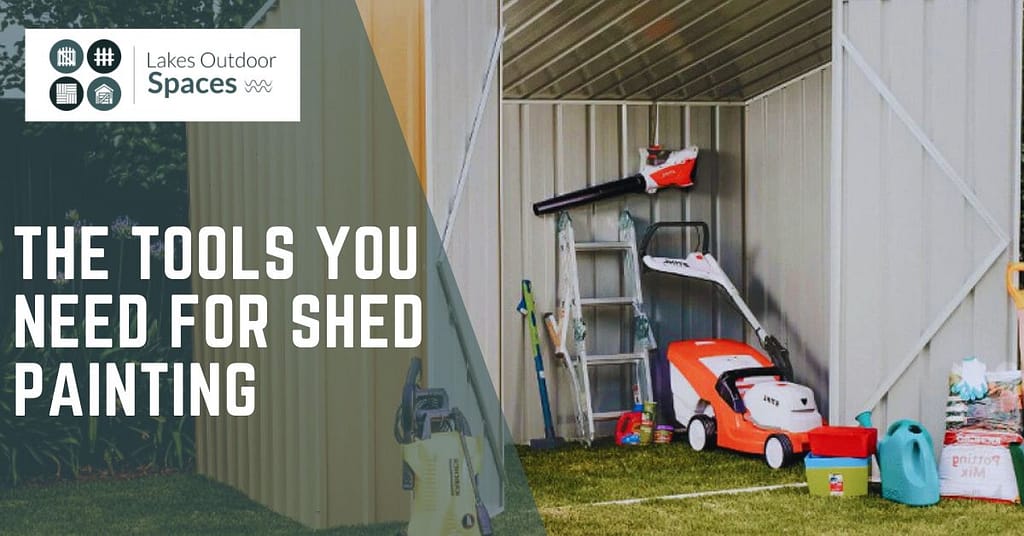A freshly painted shed can do wonders for your outdoor space. Not only does it enhance the aesthetic appeal of your backyard, but it also provides long-lasting protection against weather conditions. Proper shed painting is essential for maintaining your shed’s integrity and appearance for years to come. This shed preservation process is an investment that protects your structure from the elements, prevents damage, and reduces maintenance costs.
Whether you’re looking to revamp an old, worn-out shed or simply give it a fresh look, this guide will provide you with all the information you need to succeed. From choosing the best paint for sheds to shed maintenance tips, we’ll walk you through every essential step of the painting process.
Why Shed Painting is Important for Shed Preservation in South Lakes & North Lancashire
When it comes to shed painting, the benefits go far beyond a visual upgrade. The right paint acts as a protective layer, guarding your shed from the sun’s UV rays, rain, snow, and other weather elements that could otherwise cause significant wear. Over time, exposure to moisture can lead to wood rot, rust, or mildew, all of which compromise your shed’s structural integrity. This is where shed preservation comes in.
In the unpredictable weather conditions of South Lakes and North Lancashire, it’s especially important to choose the right paint and regular maintenance practices. Regular shed maintenance, including painting and treatment, is key to ensuring your shed’s longevity and appearance despite the harsh elements of the region.
The Tools You Need for Shed Painting

Before finding more about the painting process, it’s important to gather the necessary tools. Using the right equipment will make the project easier and ensure you achieve a professional-quality finish.
- Paintbrushes and Rollers: Choose high-quality brushes for edges and detailed areas, and rollers for large surfaces. Brushes allow for more precision, while rollers cover large areas quickly and evenly.
- Ladder: Make sure you have a sturdy ladder for reaching the top of your shed, especially if it’s tall.
- Pressure Washer or Hose: Cleaning the shed is a crucial step, and using a pressure washer can make the job faster and more efficient.
- Drop Cloths: Lay these around your shed to protect the ground and any nearby plants from paint splatters.
- Sandpaper: This is essential for smoothing rough areas and ensuring better adhesion for the paint.
- Exterior Paint: Choose paint designed for the specific material of your shed. Whether it’s wood, metal, or vinyl, selecting the right paint is crucial for a long-lasting finish.
- Primer (Optional): For bare wood or metal sheds, a primer ensures better adhesion and helps the paint last longer.
- Protective Gear: Wear gloves, goggles, and a face mask to protect yourself from fumes and paint splatters.
Step 1: Preparing Your Shed for Painting
Proper preparation is the key to achieving a smooth, durable paint job. Follow these steps to ensure your shed is ready for the painting process:
Clean the Surface
The first step in shed painting is cleaning the shed thoroughly. Over time, dirt, dust, algae, and mould can accumulate on the surface, preventing the paint from adhering properly. Use a pressure washer to blast away dirt and grime. If you don’t have a pressure washer, a garden hose and sponge can work, though it might take longer. For stubborn dirt or mildew, use a mild cleaning solution or a mixture of bleach and water to scrub the surface.
Inspect for Damage
Once the shed is clean, take the time to inspect it for any damage. Look for cracks, holes, or signs of rot, especially if you have a wooden shed. If you spot any issues, make sure to fix them before proceeding. For small cracks, use wood filler or caulk to fill the gaps. For larger shed repairs, you may need to replace damaged boards or panels.
Sand the Surface
Next, use sandpaper to smooth out rough spots and to remove any old, peeling paint. Sanding helps create a smoother surface and allows the new paint to adhere better. Be sure to sand any areas where the previous paint has chipped or where the wood is exposed. If you’re working with metal, sand any rust spots to prevent further corrosion.
More to Read: How to Waterproof Your Garden Shed in South Lakes and North Lancashire
Step 2: Choosing the Right Paint for Your Shed
Choosing the right paint for sheds is one of the most important steps in the painting process. Not all paints are suitable for outdoor structures, so it’s essential to pick a high-quality, weather-resistant product that matches the material of your shed.
Weather-Resistant Paint
Outdoor sheds face a variety of environmental stressors, such as sun exposure, rain, and snow. Weather-resistant paint is specifically designed to withstand these conditions. It helps prevent the paint from fading, peeling, or cracking, ensuring your shed looks great and stays protected.
Type of Paint
The type of paint you choose should depend on the material of your shed. Here are some paint recommendations for different shed types:
- Wooden Sheds: Use an exterior acrylic latex paint that is durable, easy to apply, and resistant to mould and mildew. If the wood is untreated, apply a primer before painting.
- Metal Sheds: Use rust-resistant enamel paint that prevents corrosion and provides a tough, durable finish.
- Vinyl Sheds: Vinyl sheds require paint designed specifically for plastic surfaces. Look for paints that offer adhesion to non-porous surfaces.
Finish
Paint finishes range from matte to glossy. A matte finish has a more natural look, while a glossy finish provides a shiny appearance and additional protection. Consider the look you want to achieve, but keep in mind that glossy finishes are easier to clean and may provide more protection.
Step 3: Applying the First Coat of Paint
With your shed prepped and your paint ready, it’s time to apply the first coat. If you’re working with bare wood or metal, start by applying a coat of primer. Primer helps paint adhere better and improves coverage.
Painting Technique
When it comes to applying the paint, there are a few painting techniques that can help you achieve a flawless finish:
- Brush for Detail Work: Use a high-quality brush to paint the edges, corners, and other detailed areas. This ensures that you don’t miss any spots.
- Roller for Large Areas: For larger surfaces, such as the sides of the shed, use a roller. A roller covers more area quickly and ensures an even application.
- Thin, Even Coats: Apply thin, even coats of paint to avoid drips or streaks. It’s better to apply multiple thin layers than to load the brush with too much paint.
After applying the first coat, allow the paint to dry according to the manufacturer’s instructions. This could take several hours, depending on the weather and the type of paint used.
Step 4: Applying the Second Coat
Once the first coat is dry, apply a second coat of paint. This step ensures even coverage and provides additional protection for your shed. Be sure to inspect the first coat before applying the second. If you notice any missed spots, touch them up before continuing.
Allow the second coat to dry completely before moving on to the next step.
Step 5: Finishing Touches
Once your shed is fully painted and dry, take a step back and inspect your work. Look for areas that may need touch-ups, especially around corners or edges. You can use a small brush to fix any missed spots.
If you want extra protection, consider applying a clear sealant or topcoat to protect the paint from scratches and the elements. A clear finish can help keep your shed looking great for longer.
Shed Maintenance Tips for Long-Term Preservation in South Lakes & North Lancashire
Maintaining your shed after painting is just as important as the initial shed preservation process. Here are a few tips to keep your shed in great condition:
Regular Inspections
Inspect your shed regularly for signs of damage or wear. Check for peeling paint, cracks, and water damage. Catching problems early can prevent more significant issues down the road.
Clean Your Shed
Keep your shed clean by removing debris, dirt, and leaves that might accumulate around it. Regular cleaning helps maintain the paint job and prevents moisture buildup, which can lead to rot or mould.
Repainting
Over time, even the best paint job will need touch-ups or a full recoat. Depending on the weather in South Lakes and North Lancashire, consider repainting every 3-5 years to maintain both the appearance and protection of your shed.
Apply Wood Treatment
For wooden sheds, it’s essential to treat the wood regularly to prevent rot, insects, and moisture damage. Use wood treatments designed to protect against mould, mildew, and pests.
Conclusion
DIY shed painting is a rewarding project that not only refreshes the appearance of your outdoor storage structure but also provides much-needed protection against the elements. By following the steps outlined in this guide, you can successfully preserve your shed, protect it from weather damage, and extend its lifespan in the unpredictable weather conditions of South Lakes and North Lancashire.
By choosing the right paint for sheds, using proper painting techniques, and following through with regular shed maintenance, your shed will remain in great condition for years to come. So, gather your tools, choose your paint, and get ready to revamp your outdoor space. If you need expert assistance or additional services, feel free to contact Lakes Outdoor Spaces for professional outdoor care.
FAQs
Exterior acrylic latex paint is a great choice for wooden sheds. It’s durable, easy to apply, and resistant to mould and mildew.
Depending on the weather conditions in South Lakes and North Lancashire, repainting every 3-5 years is recommended to keep the shed in good condition.
It’s not recommended to paint in extremely cold temperatures, as paint may not adhere properly. Aim for temperatures between 10°C and 30°C for optimal results.
A primer is recommended, especially for bare wood or metal. It helps paint adhere better and increases its longevity.
Regularly inspect, clean, and touch up the paint when needed. Applying wood treatment for wooden sheds will also prolong its lifespan.


Leave a Reply